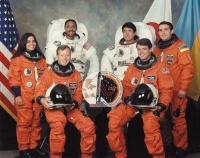STS-87
From The Space Library
 | |
| Organization | NASA-Office of Space Flight (United States) |
|---|---|
| Mission type | Human Crew,Microgravity |
| Launch date | November 19, 1997 |
| Launch vehicle | Space Shuttle |
| Launch site | Cape Canaveral, United States |
| COSPAR ID | 1997-073A |
| Inclination | 28.45 degrees |
| Experiments | Here |
| Alternate Names | 25061 |
| Additional Information | Here |
| Data Collection | Here |
| Payload Mass Up | 10038 kg |
| Payload Mass Down | 10059.09 kg |
| Orbiter | Columbia |
| Lift Off Mass | 2,056,110.00 kg |
| Orbiter Weight at Liftoff | 118,545.00 kg |
| Orbiter Weight at Landing | 105,284.09 kg |
| Landed | Concrete runway 33 at Kennedy Space Center, Fla. |
| Orbits of Earth | 252 |
| Orbital Altitude | 150 nautical miles (173 statute miles) |
Contents |
[edit] Crew
- Commander: Kevin R. Kregel
- Pilot: Steven W. Lindsey
- Payload Commander:
- Mission Specialist 1: Kalpana Chawla
- Mission Specialist 2: Winston E. Scott
- Mission Specialist 3: Takao Doi, National Space Development Agency of Japan
- Mission Specialist 4:
- Mission Specialist 5:
- Payload Specialist 1: Leonid Kadenyuk, National Space Agency of Ukraine
- Payload Specialist 2:
ISS/Mir Crew Transport
[edit] Mission
STS-87 Flew the United States Microgravity Payload (USMP-4), the Spartan-201, the Orbital Acceleration Research Experiment (OARE), the EVA Demonstration Flight Test 5 (EDFT-05), the Shuttle Ozone Limb Sending Experiment (SOLSE), the Loop Heat Pipe (LHP), the Sodium Sulfur Battery Experiment (NaSBE), the Turbulent GAS Jet Diffusion (G-744) experiment and the Autonomous EVA Robotic Camera/Sprint (AERCam/Sprint) experiment. Two middeck experiments were the Middeck Glovbox Payload (MGBX) and the Collaborative Ukrainian Experiment (CUE). The United States Microgravity Payload (USMP-4) was a Spacelab project managed by Marshall Space Flight Center, Huntsville, Alabama. The complement of microgravity research experiments was divided between two Mission-Peculiar Experiment Support Structures (MPESS) in the payload bay. The extended mission capability offered by the Extended Duration Orbiter (EDO) kit provided an opportunity for additional science gathering time. The crew consisted of the following: Kevin E. Kregel - Commander Steven W. Lindsey - Pilot Winston E. Scott - Mission Specialist Kalpana Chawla - Mission Specialist Takao Doi (NASDA) - Mission Specialist Leonid K. Kadenyuk - Payload Specialist
[edit] EVA
Extravehicular Activity (EVA) conducted by Winston Scott and Takao Doi during two spacewalks for a total of 12 hours, 42 minutes. EVA 1, Scott and Doi, 7 hours, 43 minutes; Scott and Doi manually captured the SPARTAN satellite, whose attitude control system had failed following its release from Columbia's robot arm on Nov. 21. The two also evaluated equipment and procedures that will be used with future International Space Station operations. EVA 2, Scott and Doi, 4 hours, 59 minutes; Scott and Doi completed tasks originally planned for the mission's first spacewalk. They also used the SPARTAN satellite as a laser target to prepare for future automatic spacecraft dockings. In addition, they tested the AER Camera/Sprint, a free-flying video camera designed to perform remote inspections of the shuttle or station.
[edit] Payload
Shuttle Pointed Autonomous Research Tool for Astronomy (SPARTAN) 201-04; United States Microgravity Payload (SMP) 4; Extravehicular Activity (EVA) Demonstration Flight Test (EDFT) 05; Shuttle Ozone Limb Sounding Experiment (SOLSE); Loop Heat Pipe (LHP); Sodium Sulfur Battery Experiment (NaSBE); Turbulent Gas Jet Diffusion Flames (TGDF); Getaway Special (GAS) 036; Shuttle Ionospheric Modification With Pulsed Local Exhaust (SIMPLEX); Collaborative Ukraine Experiment (CUE); Autonomous EVA Robotic (AER) Camera/ Sprint; Midcourse Space Experiment (MSX)
[edit] Books about the Space Shuttle Program
Buy This Book Click here |
Buy This Book here |
Buy This Book Click here |
Buy This Book Click here |





